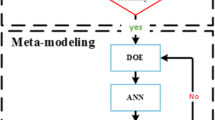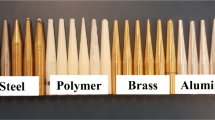Abstract
The design of packaging bags for passive components is becoming increasingly difficult because these components are being miniaturized. In this study, packaging for passive components was manufactured by a punching process. A single 12-punch die set was utilized experimentally with the aim of improving production efficiency. The neural network was applied to establish a model based on the relationship between a variety of factors: position number of micro multi-punch die set, total punched lengths, clearance, and wear. A simulated annealing (SA) optimization algorithm with a performance index was applied to the neural network. This determined the optimal punching parameters and resulted in a satisfactory outcome. Engineers can utilize this technique in practice to find optimal processing parameters, thus avoiding poor design of punching die and the need for lengthy repairs. The neural network can predict individual wear of each punch (or die cavity) under any clearance at a specific punch-length. Accurate prediction of punch/die wear means that worn components may be replaced in a timely manner, avoiding the fabrication of poor-quality products. Engineers can utilize the results on the factory floor to find optimal clearance conditions. This avoids poor design of punching die and the need for lengthy repairs.














Similar content being viewed by others
References
Sanchez LR, Weimann KJ, Gerdeen JC (1988) Deformation behavior and force analysis of sheet metal between circular draw-bends, 16th NAMRC 1988, pp 252–258
Liu F, Sowerby R (1991) The determination of optimum blank shapes when deep drawing prismatic cups. J Mater Shaping Technol 9(3):153–159
Aita S, Di Pasqual E, Haug E (1991) Sheet metal forming simulation and process optimization methodology. ESI (Engineering Systems International) PAM ’91 Seminar paper, pp 91–99
Tai CC, Lin JC (1998) The optimization deep-draw clearance design for deep-draw dies. Int J Adv Manuf Technol 14:390–398
Lin JC, Tai CC (1999) The application of neural network in the prediction of spring-back in an L-shaped bend. Int J Adv Manuf Technol 15:163–170
Luo SY (1999) Effect of the geometry and the surface treatment of punching tools on the tool life and wear conditions in the piercing of thick steel plate. J Mater Process Technol 88:122–133
Cheung CF, Lee WB, Chiu WM (2000) An investigation of tool wear in the dam-bar cutting of integrated circuit packages. Wear 23:274–282
Chiou HN (1992) Punching operation and burr treatment. Machinery Monthly Taiwan 18(11):113–122
Montgomery GJ, Drake KC (1991) Abductive reasoning network. Neurocomputing 2:97–104
Ivakhnenko AG (1971) Polynomial theory of complex systems. IEEE Trans Syst Man Cyber 1(4):364–378
Barron AR (1984) Predicted square error: a criterion for automatic model selection, self-organizing methods in modeling. In: Farlow SJ (ed) GMDH type algorithms. Marcel-Dekker, New York
Metropolis N, Rosenbluth A, Rosenbluth M, Teller A, Teller E (1953) Equation of state calculation by fast computing machines. J Chem Phys 21:1087–1092
Kirkpatrick S, Gelatt CD Jr, Vecchi MP (1983) Optimization by simulated annealing. Science 220(4598):671–680
Author information
Authors and Affiliations
Corresponding author
Appendix: The abductive network of punch AO-side
Appendix: The abductive network of punch AO-side

(N normalizer node, W white Node, S single node, T triple node, PSE = 4.2958 × 10−7)
Rights and permissions
About this article
Cite this article
Lee, K. Predictions of the life for micro multi-punch die using neural network. Engineering with Computers 27, 155–164 (2011). https://doi.org/10.1007/s00366-010-0184-8
Received:
Accepted:
Published:
Issue Date:
DOI: https://doi.org/10.1007/s00366-010-0184-8




